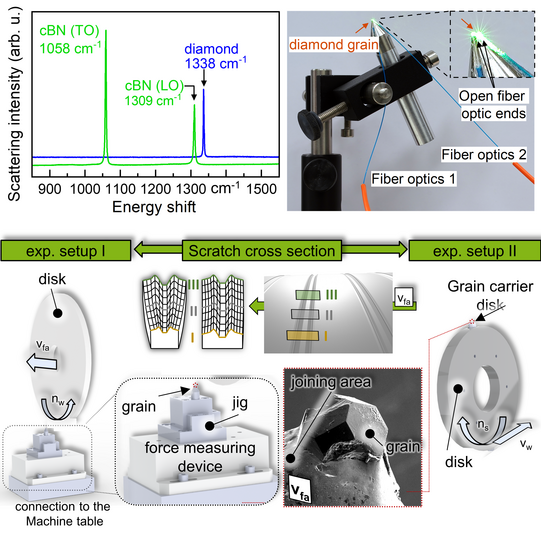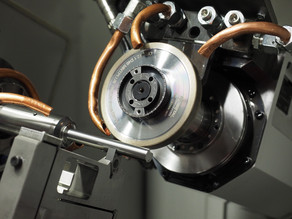Determination of the microscopic wear mechanisms and operational suitability of diamond and cBN for the precision machining of hardened steel under variation of the thermomechanical load using multiscale measurement methods
Cubic boron nitride (cBN) is a superabrasive material frequently used for machining steels due to its high thermochemical resistance. Compared to cBN, diamond possesses superior mechanical properties and allows longer tool life at low process temperatures; however, it is less temperature-resistant. The wear mechanisms of the diamond and cBN tools for machining steels are not yet understood, which limits their applications and, in turn, indicates a research gap. Moreover, it is of particular interest how the predictability of the precision-grinding result and the reliability of the abrasive grain functionality using diamond and cBN could be enhanced. The understanding of the interaction of diamond and cBN with a steel surface and, hence, of the abrasive grain wear at the nanoscale is moreover an open tribological aspect. It could be clarified by a microscopic description of the wear-relevant properties of the grain surface and their dependences on the temperature and pressure.
The project aims at describing chemical, structural, and physical surface properties of diamond and cBN abrasive grains as well as of the workpiece made of hardened bearing steel 100Cr6 at the meso- and nanoscale; following the conditions of grinding processes, the thermomechanical load is varied. The mutually correlated properties shall characterize the grain wear mechanisms for the precision grinding as well as the suitability and efficiency of the abrasive grains for realizing a high surface quality of the workpiece. On the one hand, acoustic phonons shall describe the energy, which is dissipated into the carbon or boron-nitride atomic lattice during the grinding process and shall be linked with macro- and microscopic analyses of the wear and friction. On the other hand, application-specific process-parameter spaces for the precise machining with cBN and diamond grinding tools and potential limits and advantages of using diamond in comparison to cBN will be deduced. The wear resistance and the material abrasion performance will finally be elucidated for the target-oriented and economical application of cBN and diamond as grinding medium in precision grinding.
In that context, complementary and multiscale methods, which embrace macro- and microscopic studies of structural-topographic features will be used and interatomic interactions which are relevant to chemical and physical properties will be analyzed by means of Raman and Brillouin laser-light scattering. The thermomechanical load of diamond and cBN abrasive grains being in contact with the workpiece surface will be recorded in situ and operando by a quantum sensor measurement of pressure and temperature. The Institute of Machining Technology and the Experimental Physics 2 will carry out the research and development work required as part of the project.





![[Translate to English:] [Translate to English:]](/storages/isf-mb/_processed_/4/8/csm_Schleifscheiben_8bb5d31229.jpg)